ENG93000 Assignment: Sustainable Engineering at Western Sydney Airport
VerifiedAdded on 2022/10/02
|10
|2384
|368
Case Study
AI Summary
This case study examines the Western Sydney Airport (WSA) project, focusing on its sustainable design and construction. The assignment begins with an introduction highlighting the airport's role in meeting Sydney's growing aviation demand and its commitment to 21st-century technology and sustainable practices. It then details the project's environmental considerations, including air and water quality, noise levels, biodiversity conservation, and the mitigation of potential health risks. The study outlines how sustainability requirements are embedded in the project, such as land use protection, and the use of best practice technologies. The outcomes measured include relocation of threatened species and maintaining environmental standards. The conclusion emphasizes the project's best practices in sustainability, particularly in environmental conservation and human health considerations, referencing the latest technologies adopted in similar projects. The assignment uses the NSW Sustainable Design Guidelines.
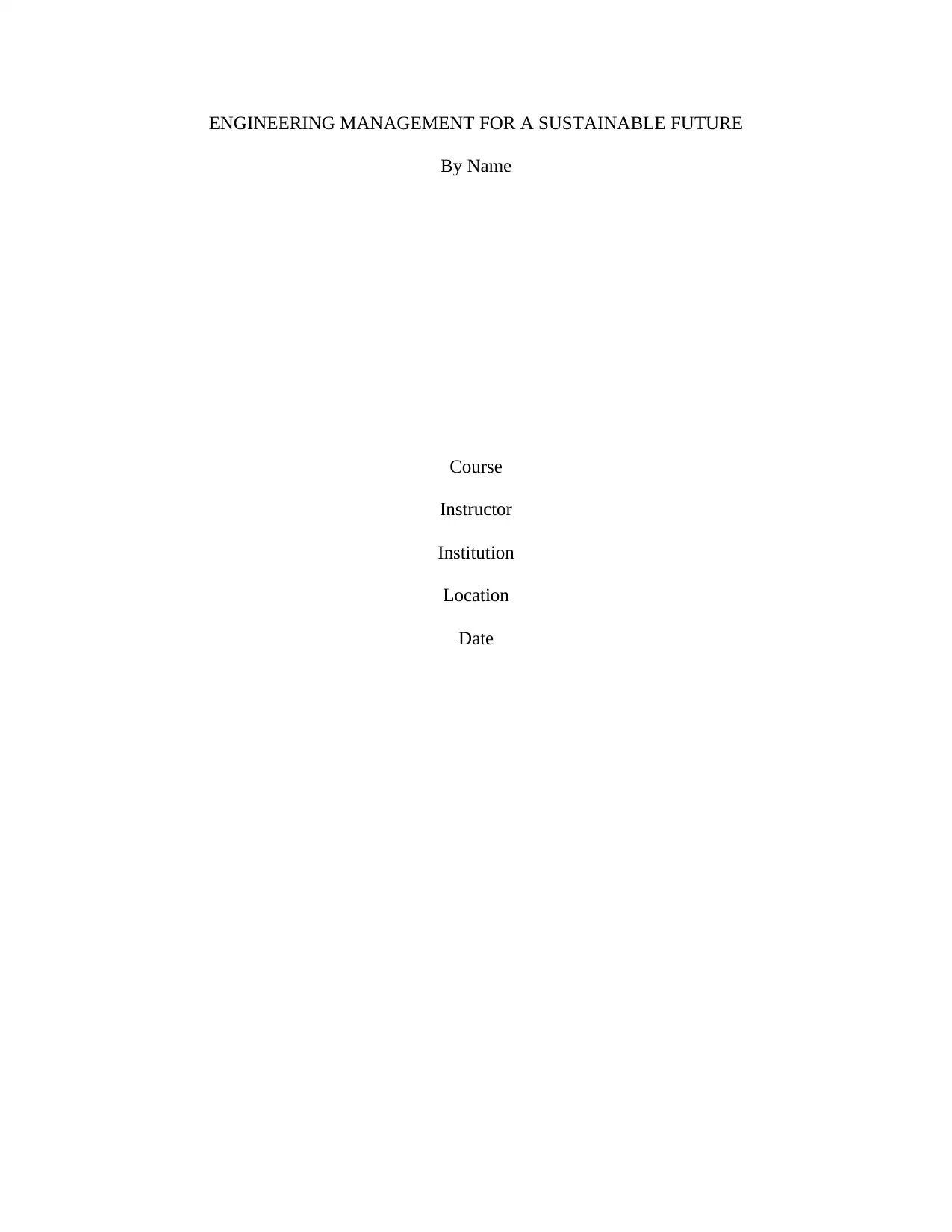
ENGINEERING MANAGEMENT FOR A SUSTAINABLE FUTURE
By Name
Course
Instructor
Institution
Location
Date
By Name
Course
Instructor
Institution
Location
Date
Paraphrase This Document
Need a fresh take? Get an instant paraphrase of this document with our AI Paraphraser
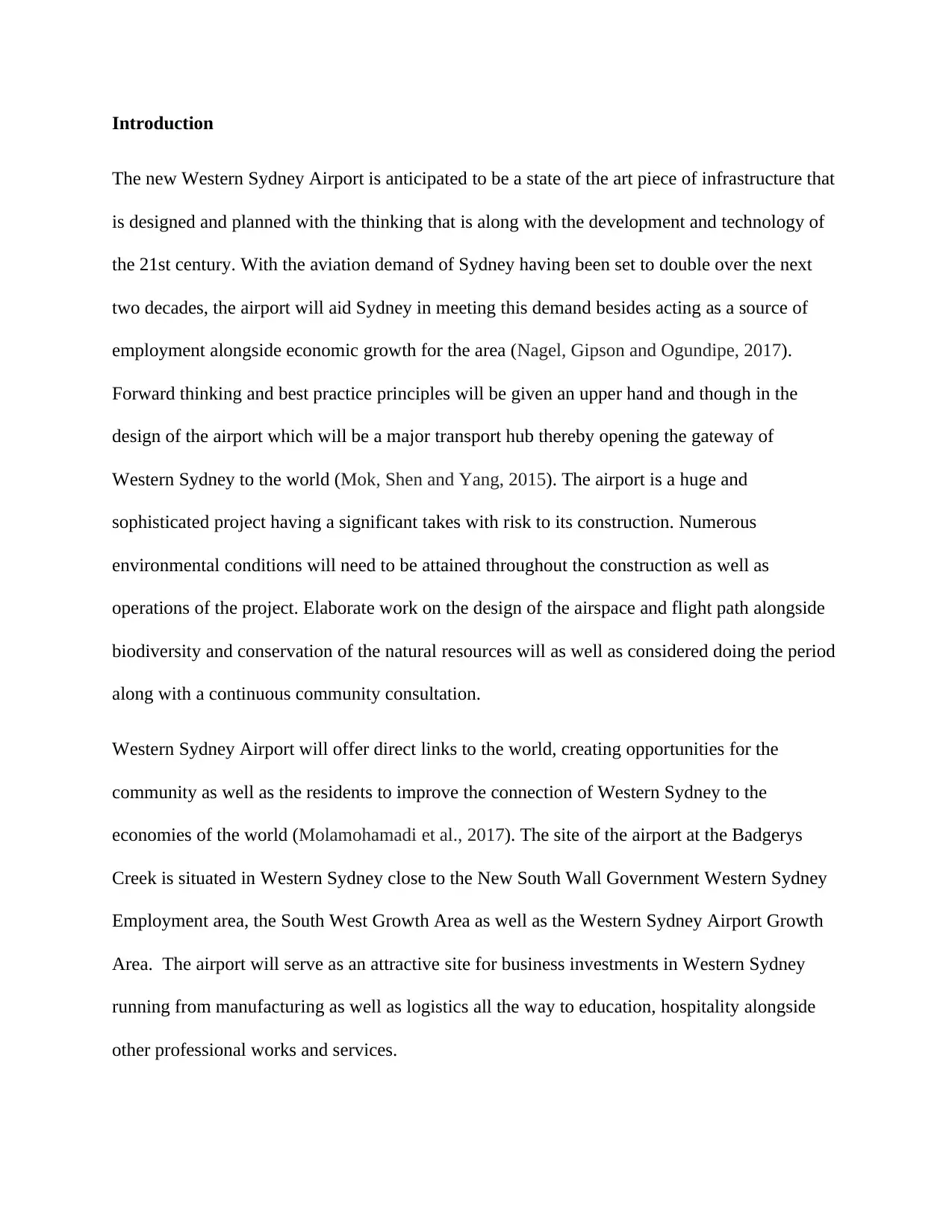
Introduction
The new Western Sydney Airport is anticipated to be a state of the art piece of infrastructure that
is designed and planned with the thinking that is along with the development and technology of
the 21st century. With the aviation demand of Sydney having been set to double over the next
two decades, the airport will aid Sydney in meeting this demand besides acting as a source of
employment alongside economic growth for the area (Nagel, Gipson and Ogundipe, 2017).
Forward thinking and best practice principles will be given an upper hand and though in the
design of the airport which will be a major transport hub thereby opening the gateway of
Western Sydney to the world (Mok, Shen and Yang, 2015). The airport is a huge and
sophisticated project having a significant takes with risk to its construction. Numerous
environmental conditions will need to be attained throughout the construction as well as
operations of the project. Elaborate work on the design of the airspace and flight path alongside
biodiversity and conservation of the natural resources will as well as considered doing the period
along with a continuous community consultation.
Western Sydney Airport will offer direct links to the world, creating opportunities for the
community as well as the residents to improve the connection of Western Sydney to the
economies of the world (Molamohamadi et al., 2017). The site of the airport at the Badgerys
Creek is situated in Western Sydney close to the New South Wall Government Western Sydney
Employment area, the South West Growth Area as well as the Western Sydney Airport Growth
Area. The airport will serve as an attractive site for business investments in Western Sydney
running from manufacturing as well as logistics all the way to education, hospitality alongside
other professional works and services.
The new Western Sydney Airport is anticipated to be a state of the art piece of infrastructure that
is designed and planned with the thinking that is along with the development and technology of
the 21st century. With the aviation demand of Sydney having been set to double over the next
two decades, the airport will aid Sydney in meeting this demand besides acting as a source of
employment alongside economic growth for the area (Nagel, Gipson and Ogundipe, 2017).
Forward thinking and best practice principles will be given an upper hand and though in the
design of the airport which will be a major transport hub thereby opening the gateway of
Western Sydney to the world (Mok, Shen and Yang, 2015). The airport is a huge and
sophisticated project having a significant takes with risk to its construction. Numerous
environmental conditions will need to be attained throughout the construction as well as
operations of the project. Elaborate work on the design of the airspace and flight path alongside
biodiversity and conservation of the natural resources will as well as considered doing the period
along with a continuous community consultation.
Western Sydney Airport will offer direct links to the world, creating opportunities for the
community as well as the residents to improve the connection of Western Sydney to the
economies of the world (Molamohamadi et al., 2017). The site of the airport at the Badgerys
Creek is situated in Western Sydney close to the New South Wall Government Western Sydney
Employment area, the South West Growth Area as well as the Western Sydney Airport Growth
Area. The airport will serve as an attractive site for business investments in Western Sydney
running from manufacturing as well as logistics all the way to education, hospitality alongside
other professional works and services.
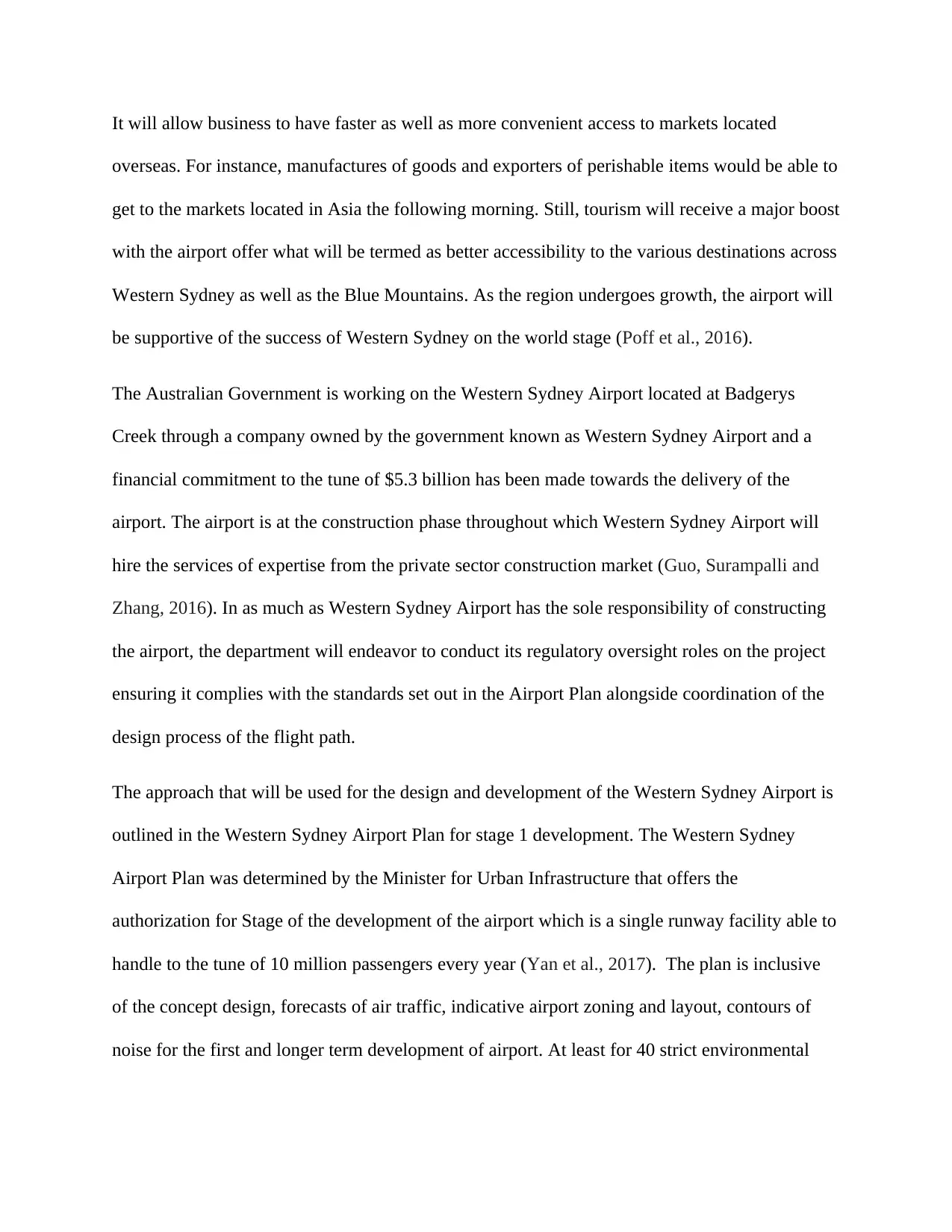
It will allow business to have faster as well as more convenient access to markets located
overseas. For instance, manufactures of goods and exporters of perishable items would be able to
get to the markets located in Asia the following morning. Still, tourism will receive a major boost
with the airport offer what will be termed as better accessibility to the various destinations across
Western Sydney as well as the Blue Mountains. As the region undergoes growth, the airport will
be supportive of the success of Western Sydney on the world stage (Poff et al., 2016).
The Australian Government is working on the Western Sydney Airport located at Badgerys
Creek through a company owned by the government known as Western Sydney Airport and a
financial commitment to the tune of $5.3 billion has been made towards the delivery of the
airport. The airport is at the construction phase throughout which Western Sydney Airport will
hire the services of expertise from the private sector construction market (Guo, Surampalli and
Zhang, 2016). In as much as Western Sydney Airport has the sole responsibility of constructing
the airport, the department will endeavor to conduct its regulatory oversight roles on the project
ensuring it complies with the standards set out in the Airport Plan alongside coordination of the
design process of the flight path.
The approach that will be used for the design and development of the Western Sydney Airport is
outlined in the Western Sydney Airport Plan for stage 1 development. The Western Sydney
Airport Plan was determined by the Minister for Urban Infrastructure that offers the
authorization for Stage of the development of the airport which is a single runway facility able to
handle to the tune of 10 million passengers every year (Yan et al., 2017). The plan is inclusive
of the concept design, forecasts of air traffic, indicative airport zoning and layout, contours of
noise for the first and longer term development of airport. At least for 40 strict environmental
overseas. For instance, manufactures of goods and exporters of perishable items would be able to
get to the markets located in Asia the following morning. Still, tourism will receive a major boost
with the airport offer what will be termed as better accessibility to the various destinations across
Western Sydney as well as the Blue Mountains. As the region undergoes growth, the airport will
be supportive of the success of Western Sydney on the world stage (Poff et al., 2016).
The Australian Government is working on the Western Sydney Airport located at Badgerys
Creek through a company owned by the government known as Western Sydney Airport and a
financial commitment to the tune of $5.3 billion has been made towards the delivery of the
airport. The airport is at the construction phase throughout which Western Sydney Airport will
hire the services of expertise from the private sector construction market (Guo, Surampalli and
Zhang, 2016). In as much as Western Sydney Airport has the sole responsibility of constructing
the airport, the department will endeavor to conduct its regulatory oversight roles on the project
ensuring it complies with the standards set out in the Airport Plan alongside coordination of the
design process of the flight path.
The approach that will be used for the design and development of the Western Sydney Airport is
outlined in the Western Sydney Airport Plan for stage 1 development. The Western Sydney
Airport Plan was determined by the Minister for Urban Infrastructure that offers the
authorization for Stage of the development of the airport which is a single runway facility able to
handle to the tune of 10 million passengers every year (Yan et al., 2017). The plan is inclusive
of the concept design, forecasts of air traffic, indicative airport zoning and layout, contours of
noise for the first and longer term development of airport. At least for 40 strict environmental
⊘ This is a preview!⊘
Do you want full access?
Subscribe today to unlock all pages.

Trusted by 1+ million students worldwide
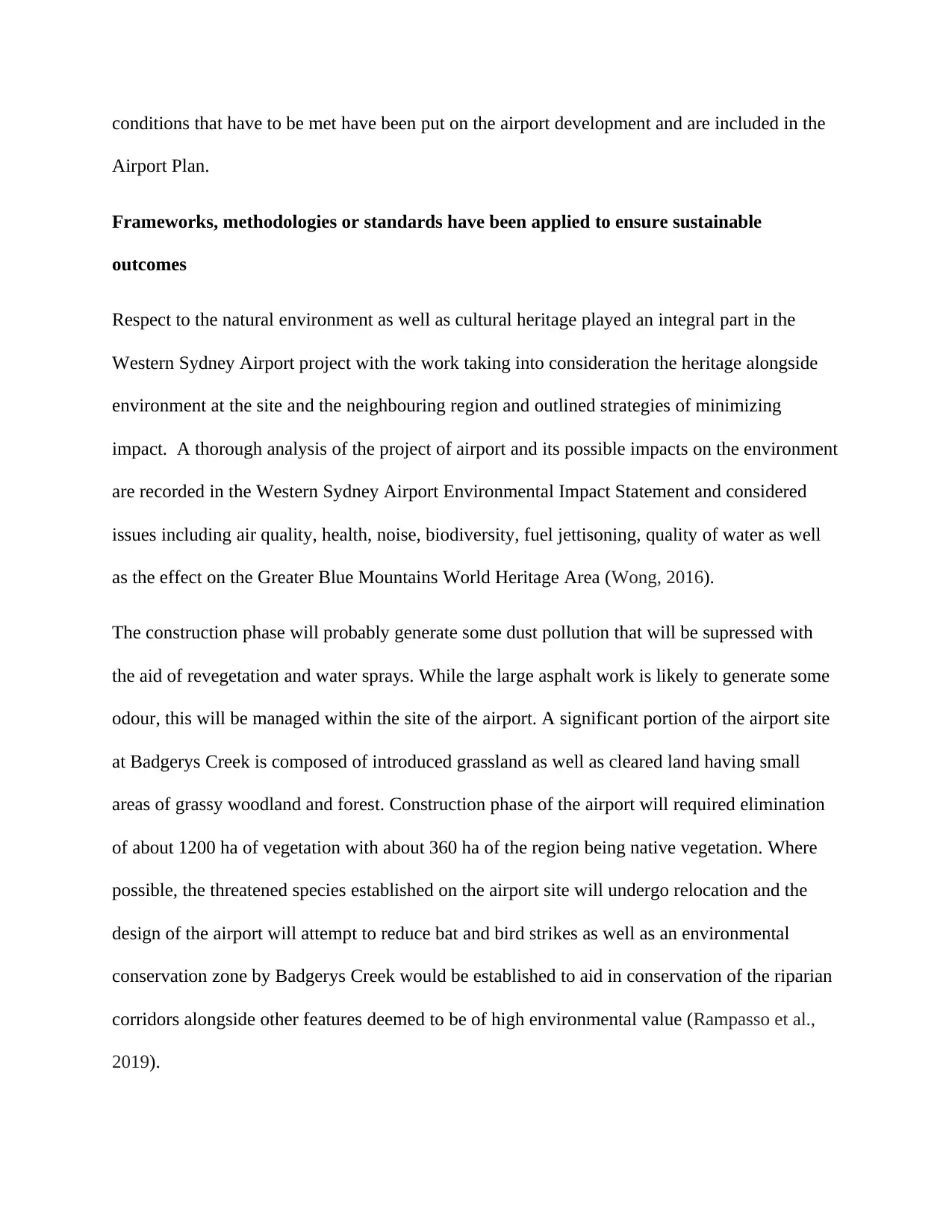
conditions that have to be met have been put on the airport development and are included in the
Airport Plan.
Frameworks, methodologies or standards have been applied to ensure sustainable
outcomes
Respect to the natural environment as well as cultural heritage played an integral part in the
Western Sydney Airport project with the work taking into consideration the heritage alongside
environment at the site and the neighbouring region and outlined strategies of minimizing
impact. A thorough analysis of the project of airport and its possible impacts on the environment
are recorded in the Western Sydney Airport Environmental Impact Statement and considered
issues including air quality, health, noise, biodiversity, fuel jettisoning, quality of water as well
as the effect on the Greater Blue Mountains World Heritage Area (Wong, 2016).
The construction phase will probably generate some dust pollution that will be supressed with
the aid of revegetation and water sprays. While the large asphalt work is likely to generate some
odour, this will be managed within the site of the airport. A significant portion of the airport site
at Badgerys Creek is composed of introduced grassland as well as cleared land having small
areas of grassy woodland and forest. Construction phase of the airport will required elimination
of about 1200 ha of vegetation with about 360 ha of the region being native vegetation. Where
possible, the threatened species established on the airport site will undergo relocation and the
design of the airport will attempt to reduce bat and bird strikes as well as an environmental
conservation zone by Badgerys Creek would be established to aid in conservation of the riparian
corridors alongside other features deemed to be of high environmental value (Rampasso et al.,
2019).
Airport Plan.
Frameworks, methodologies or standards have been applied to ensure sustainable
outcomes
Respect to the natural environment as well as cultural heritage played an integral part in the
Western Sydney Airport project with the work taking into consideration the heritage alongside
environment at the site and the neighbouring region and outlined strategies of minimizing
impact. A thorough analysis of the project of airport and its possible impacts on the environment
are recorded in the Western Sydney Airport Environmental Impact Statement and considered
issues including air quality, health, noise, biodiversity, fuel jettisoning, quality of water as well
as the effect on the Greater Blue Mountains World Heritage Area (Wong, 2016).
The construction phase will probably generate some dust pollution that will be supressed with
the aid of revegetation and water sprays. While the large asphalt work is likely to generate some
odour, this will be managed within the site of the airport. A significant portion of the airport site
at Badgerys Creek is composed of introduced grassland as well as cleared land having small
areas of grassy woodland and forest. Construction phase of the airport will required elimination
of about 1200 ha of vegetation with about 360 ha of the region being native vegetation. Where
possible, the threatened species established on the airport site will undergo relocation and the
design of the airport will attempt to reduce bat and bird strikes as well as an environmental
conservation zone by Badgerys Creek would be established to aid in conservation of the riparian
corridors alongside other features deemed to be of high environmental value (Rampasso et al.,
2019).
Paraphrase This Document
Need a fresh take? Get an instant paraphrase of this document with our AI Paraphraser
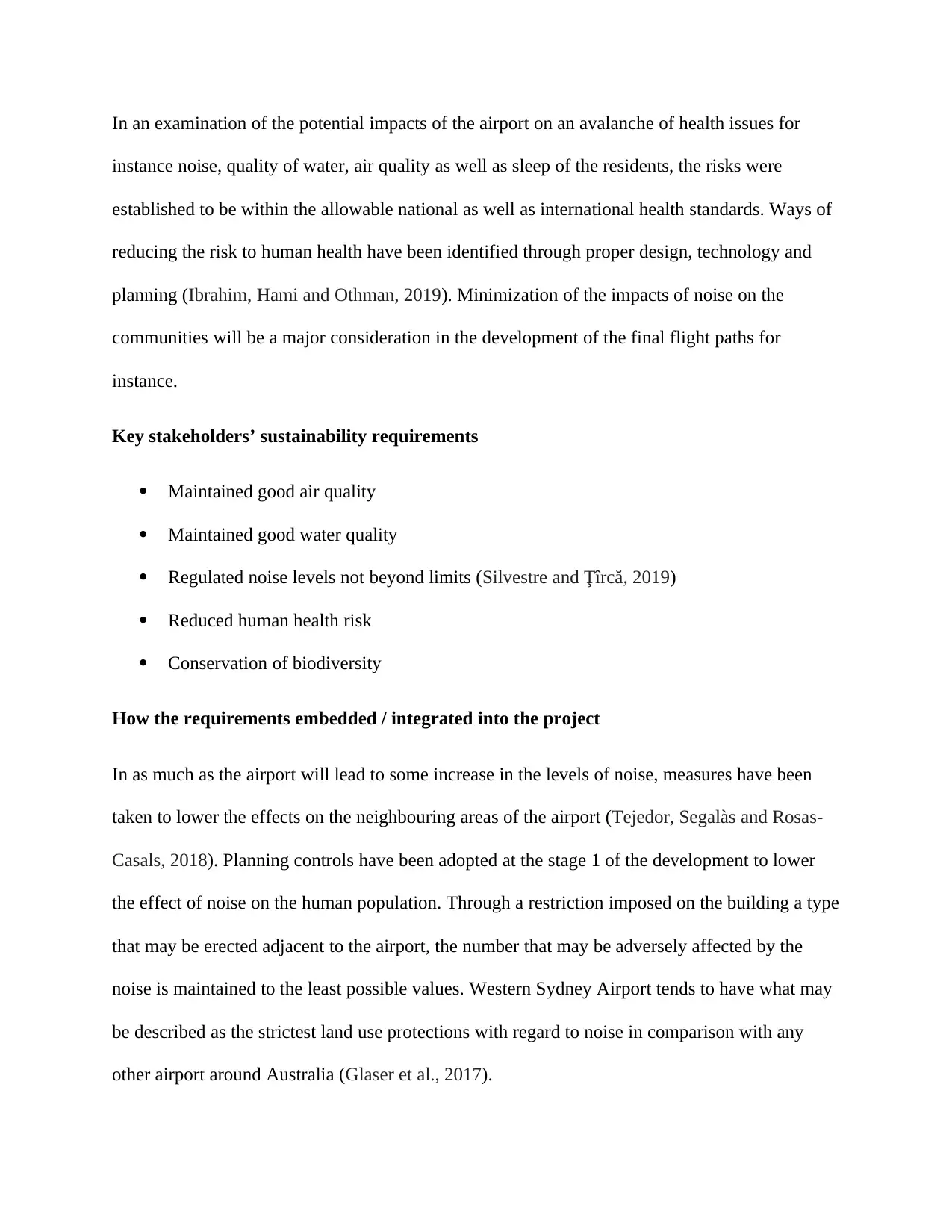
In an examination of the potential impacts of the airport on an avalanche of health issues for
instance noise, quality of water, air quality as well as sleep of the residents, the risks were
established to be within the allowable national as well as international health standards. Ways of
reducing the risk to human health have been identified through proper design, technology and
planning (Ibrahim, Hami and Othman, 2019). Minimization of the impacts of noise on the
communities will be a major consideration in the development of the final flight paths for
instance.
Key stakeholders’ sustainability requirements
Maintained good air quality
Maintained good water quality
Regulated noise levels not beyond limits (Silvestre and Ţîrcă, 2019)
Reduced human health risk
Conservation of biodiversity
How the requirements embedded / integrated into the project
In as much as the airport will lead to some increase in the levels of noise, measures have been
taken to lower the effects on the neighbouring areas of the airport (Tejedor, Segalàs and Rosas-
Casals, 2018). Planning controls have been adopted at the stage 1 of the development to lower
the effect of noise on the human population. Through a restriction imposed on the building a type
that may be erected adjacent to the airport, the number that may be adversely affected by the
noise is maintained to the least possible values. Western Sydney Airport tends to have what may
be described as the strictest land use protections with regard to noise in comparison with any
other airport around Australia (Glaser et al., 2017).
instance noise, quality of water, air quality as well as sleep of the residents, the risks were
established to be within the allowable national as well as international health standards. Ways of
reducing the risk to human health have been identified through proper design, technology and
planning (Ibrahim, Hami and Othman, 2019). Minimization of the impacts of noise on the
communities will be a major consideration in the development of the final flight paths for
instance.
Key stakeholders’ sustainability requirements
Maintained good air quality
Maintained good water quality
Regulated noise levels not beyond limits (Silvestre and Ţîrcă, 2019)
Reduced human health risk
Conservation of biodiversity
How the requirements embedded / integrated into the project
In as much as the airport will lead to some increase in the levels of noise, measures have been
taken to lower the effects on the neighbouring areas of the airport (Tejedor, Segalàs and Rosas-
Casals, 2018). Planning controls have been adopted at the stage 1 of the development to lower
the effect of noise on the human population. Through a restriction imposed on the building a type
that may be erected adjacent to the airport, the number that may be adversely affected by the
noise is maintained to the least possible values. Western Sydney Airport tends to have what may
be described as the strictest land use protections with regard to noise in comparison with any
other airport around Australia (Glaser et al., 2017).
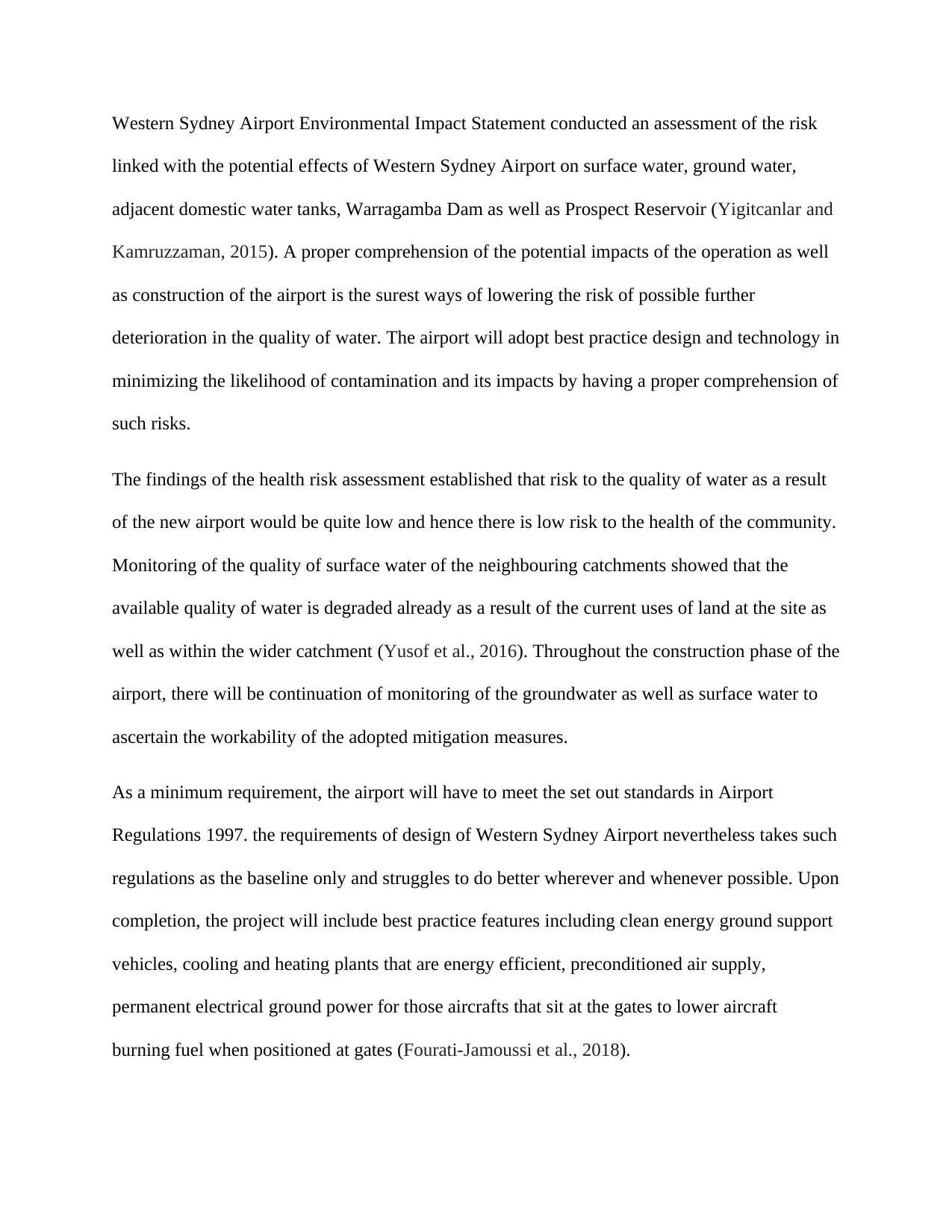
Western Sydney Airport Environmental Impact Statement conducted an assessment of the risk
linked with the potential effects of Western Sydney Airport on surface water, ground water,
adjacent domestic water tanks, Warragamba Dam as well as Prospect Reservoir (Yigitcanlar and
Kamruzzaman, 2015). A proper comprehension of the potential impacts of the operation as well
as construction of the airport is the surest ways of lowering the risk of possible further
deterioration in the quality of water. The airport will adopt best practice design and technology in
minimizing the likelihood of contamination and its impacts by having a proper comprehension of
such risks.
The findings of the health risk assessment established that risk to the quality of water as a result
of the new airport would be quite low and hence there is low risk to the health of the community.
Monitoring of the quality of surface water of the neighbouring catchments showed that the
available quality of water is degraded already as a result of the current uses of land at the site as
well as within the wider catchment (Yusof et al., 2016). Throughout the construction phase of the
airport, there will be continuation of monitoring of the groundwater as well as surface water to
ascertain the workability of the adopted mitigation measures.
As a minimum requirement, the airport will have to meet the set out standards in Airport
Regulations 1997. the requirements of design of Western Sydney Airport nevertheless takes such
regulations as the baseline only and struggles to do better wherever and whenever possible. Upon
completion, the project will include best practice features including clean energy ground support
vehicles, cooling and heating plants that are energy efficient, preconditioned air supply,
permanent electrical ground power for those aircrafts that sit at the gates to lower aircraft
burning fuel when positioned at gates (Fourati-Jamoussi et al., 2018).
linked with the potential effects of Western Sydney Airport on surface water, ground water,
adjacent domestic water tanks, Warragamba Dam as well as Prospect Reservoir (Yigitcanlar and
Kamruzzaman, 2015). A proper comprehension of the potential impacts of the operation as well
as construction of the airport is the surest ways of lowering the risk of possible further
deterioration in the quality of water. The airport will adopt best practice design and technology in
minimizing the likelihood of contamination and its impacts by having a proper comprehension of
such risks.
The findings of the health risk assessment established that risk to the quality of water as a result
of the new airport would be quite low and hence there is low risk to the health of the community.
Monitoring of the quality of surface water of the neighbouring catchments showed that the
available quality of water is degraded already as a result of the current uses of land at the site as
well as within the wider catchment (Yusof et al., 2016). Throughout the construction phase of the
airport, there will be continuation of monitoring of the groundwater as well as surface water to
ascertain the workability of the adopted mitigation measures.
As a minimum requirement, the airport will have to meet the set out standards in Airport
Regulations 1997. the requirements of design of Western Sydney Airport nevertheless takes such
regulations as the baseline only and struggles to do better wherever and whenever possible. Upon
completion, the project will include best practice features including clean energy ground support
vehicles, cooling and heating plants that are energy efficient, preconditioned air supply,
permanent electrical ground power for those aircrafts that sit at the gates to lower aircraft
burning fuel when positioned at gates (Fourati-Jamoussi et al., 2018).
⊘ This is a preview!⊘
Do you want full access?
Subscribe today to unlock all pages.

Trusted by 1+ million students worldwide
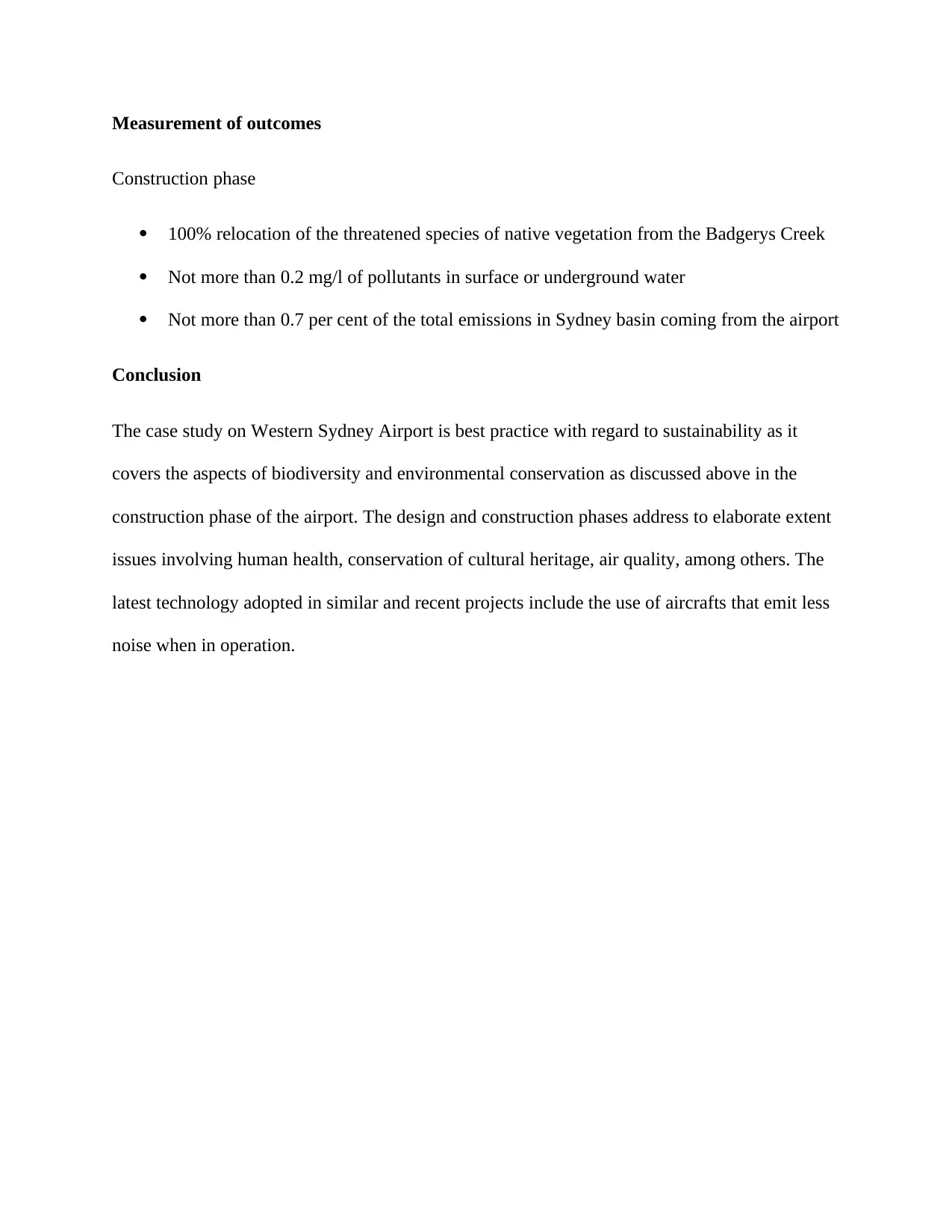
Measurement of outcomes
Construction phase
100% relocation of the threatened species of native vegetation from the Badgerys Creek
Not more than 0.2 mg/l of pollutants in surface or underground water
Not more than 0.7 per cent of the total emissions in Sydney basin coming from the airport
Conclusion
The case study on Western Sydney Airport is best practice with regard to sustainability as it
covers the aspects of biodiversity and environmental conservation as discussed above in the
construction phase of the airport. The design and construction phases address to elaborate extent
issues involving human health, conservation of cultural heritage, air quality, among others. The
latest technology adopted in similar and recent projects include the use of aircrafts that emit less
noise when in operation.
Construction phase
100% relocation of the threatened species of native vegetation from the Badgerys Creek
Not more than 0.2 mg/l of pollutants in surface or underground water
Not more than 0.7 per cent of the total emissions in Sydney basin coming from the airport
Conclusion
The case study on Western Sydney Airport is best practice with regard to sustainability as it
covers the aspects of biodiversity and environmental conservation as discussed above in the
construction phase of the airport. The design and construction phases address to elaborate extent
issues involving human health, conservation of cultural heritage, air quality, among others. The
latest technology adopted in similar and recent projects include the use of aircrafts that emit less
noise when in operation.
Paraphrase This Document
Need a fresh take? Get an instant paraphrase of this document with our AI Paraphraser
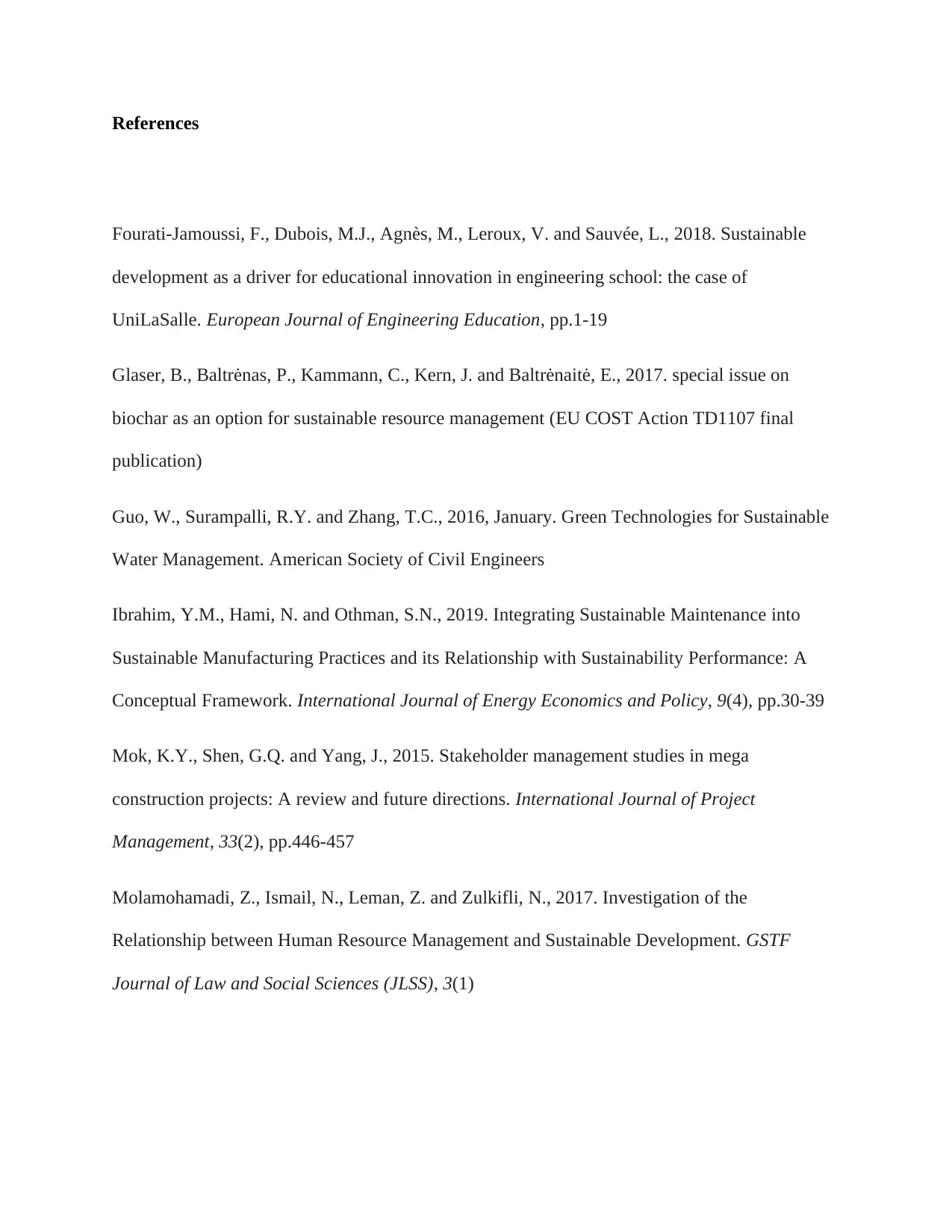
References
Fourati-Jamoussi, F., Dubois, M.J., Agnès, M., Leroux, V. and Sauvée, L., 2018. Sustainable
development as a driver for educational innovation in engineering school: the case of
UniLaSalle. European Journal of Engineering Education, pp.1-19
Glaser, B., Baltrėnas, P., Kammann, C., Kern, J. and Baltrėnaitė, E., 2017. special issue on
biochar as an option for sustainable resource management (EU COST Action TD1107 final
publication)
Guo, W., Surampalli, R.Y. and Zhang, T.C., 2016, January. Green Technologies for Sustainable
Water Management. American Society of Civil Engineers
Ibrahim, Y.M., Hami, N. and Othman, S.N., 2019. Integrating Sustainable Maintenance into
Sustainable Manufacturing Practices and its Relationship with Sustainability Performance: A
Conceptual Framework. International Journal of Energy Economics and Policy, 9(4), pp.30-39
Mok, K.Y., Shen, G.Q. and Yang, J., 2015. Stakeholder management studies in mega
construction projects: A review and future directions. International Journal of Project
Management, 33(2), pp.446-457
Molamohamadi, Z., Ismail, N., Leman, Z. and Zulkifli, N., 2017. Investigation of the
Relationship between Human Resource Management and Sustainable Development. GSTF
Journal of Law and Social Sciences (JLSS), 3(1)
Fourati-Jamoussi, F., Dubois, M.J., Agnès, M., Leroux, V. and Sauvée, L., 2018. Sustainable
development as a driver for educational innovation in engineering school: the case of
UniLaSalle. European Journal of Engineering Education, pp.1-19
Glaser, B., Baltrėnas, P., Kammann, C., Kern, J. and Baltrėnaitė, E., 2017. special issue on
biochar as an option for sustainable resource management (EU COST Action TD1107 final
publication)
Guo, W., Surampalli, R.Y. and Zhang, T.C., 2016, January. Green Technologies for Sustainable
Water Management. American Society of Civil Engineers
Ibrahim, Y.M., Hami, N. and Othman, S.N., 2019. Integrating Sustainable Maintenance into
Sustainable Manufacturing Practices and its Relationship with Sustainability Performance: A
Conceptual Framework. International Journal of Energy Economics and Policy, 9(4), pp.30-39
Mok, K.Y., Shen, G.Q. and Yang, J., 2015. Stakeholder management studies in mega
construction projects: A review and future directions. International Journal of Project
Management, 33(2), pp.446-457
Molamohamadi, Z., Ismail, N., Leman, Z. and Zulkifli, N., 2017. Investigation of the
Relationship between Human Resource Management and Sustainable Development. GSTF
Journal of Law and Social Sciences (JLSS), 3(1)
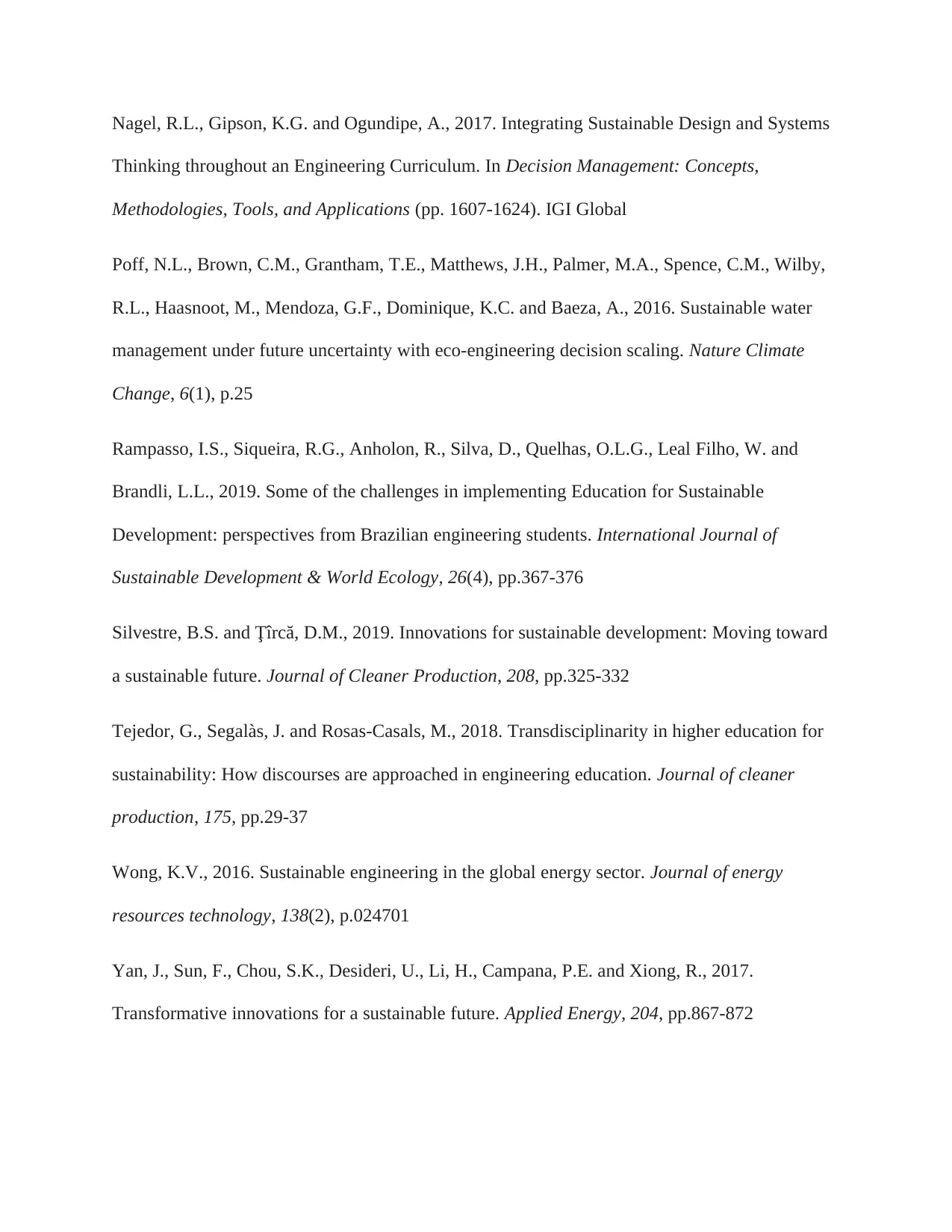
Nagel, R.L., Gipson, K.G. and Ogundipe, A., 2017. Integrating Sustainable Design and Systems
Thinking throughout an Engineering Curriculum. In Decision Management: Concepts,
Methodologies, Tools, and Applications (pp. 1607-1624). IGI Global
Poff, N.L., Brown, C.M., Grantham, T.E., Matthews, J.H., Palmer, M.A., Spence, C.M., Wilby,
R.L., Haasnoot, M., Mendoza, G.F., Dominique, K.C. and Baeza, A., 2016. Sustainable water
management under future uncertainty with eco-engineering decision scaling. Nature Climate
Change, 6(1), p.25
Rampasso, I.S., Siqueira, R.G., Anholon, R., Silva, D., Quelhas, O.L.G., Leal Filho, W. and
Brandli, L.L., 2019. Some of the challenges in implementing Education for Sustainable
Development: perspectives from Brazilian engineering students. International Journal of
Sustainable Development & World Ecology, 26(4), pp.367-376
Silvestre, B.S. and Ţîrcă, D.M., 2019. Innovations for sustainable development: Moving toward
a sustainable future. Journal of Cleaner Production, 208, pp.325-332
Tejedor, G., Segalàs, J. and Rosas-Casals, M., 2018. Transdisciplinarity in higher education for
sustainability: How discourses are approached in engineering education. Journal of cleaner
production, 175, pp.29-37
Wong, K.V., 2016. Sustainable engineering in the global energy sector. Journal of energy
resources technology, 138(2), p.024701
Yan, J., Sun, F., Chou, S.K., Desideri, U., Li, H., Campana, P.E. and Xiong, R., 2017.
Transformative innovations for a sustainable future. Applied Energy, 204, pp.867-872
Thinking throughout an Engineering Curriculum. In Decision Management: Concepts,
Methodologies, Tools, and Applications (pp. 1607-1624). IGI Global
Poff, N.L., Brown, C.M., Grantham, T.E., Matthews, J.H., Palmer, M.A., Spence, C.M., Wilby,
R.L., Haasnoot, M., Mendoza, G.F., Dominique, K.C. and Baeza, A., 2016. Sustainable water
management under future uncertainty with eco-engineering decision scaling. Nature Climate
Change, 6(1), p.25
Rampasso, I.S., Siqueira, R.G., Anholon, R., Silva, D., Quelhas, O.L.G., Leal Filho, W. and
Brandli, L.L., 2019. Some of the challenges in implementing Education for Sustainable
Development: perspectives from Brazilian engineering students. International Journal of
Sustainable Development & World Ecology, 26(4), pp.367-376
Silvestre, B.S. and Ţîrcă, D.M., 2019. Innovations for sustainable development: Moving toward
a sustainable future. Journal of Cleaner Production, 208, pp.325-332
Tejedor, G., Segalàs, J. and Rosas-Casals, M., 2018. Transdisciplinarity in higher education for
sustainability: How discourses are approached in engineering education. Journal of cleaner
production, 175, pp.29-37
Wong, K.V., 2016. Sustainable engineering in the global energy sector. Journal of energy
resources technology, 138(2), p.024701
Yan, J., Sun, F., Chou, S.K., Desideri, U., Li, H., Campana, P.E. and Xiong, R., 2017.
Transformative innovations for a sustainable future. Applied Energy, 204, pp.867-872
⊘ This is a preview!⊘
Do you want full access?
Subscribe today to unlock all pages.

Trusted by 1+ million students worldwide
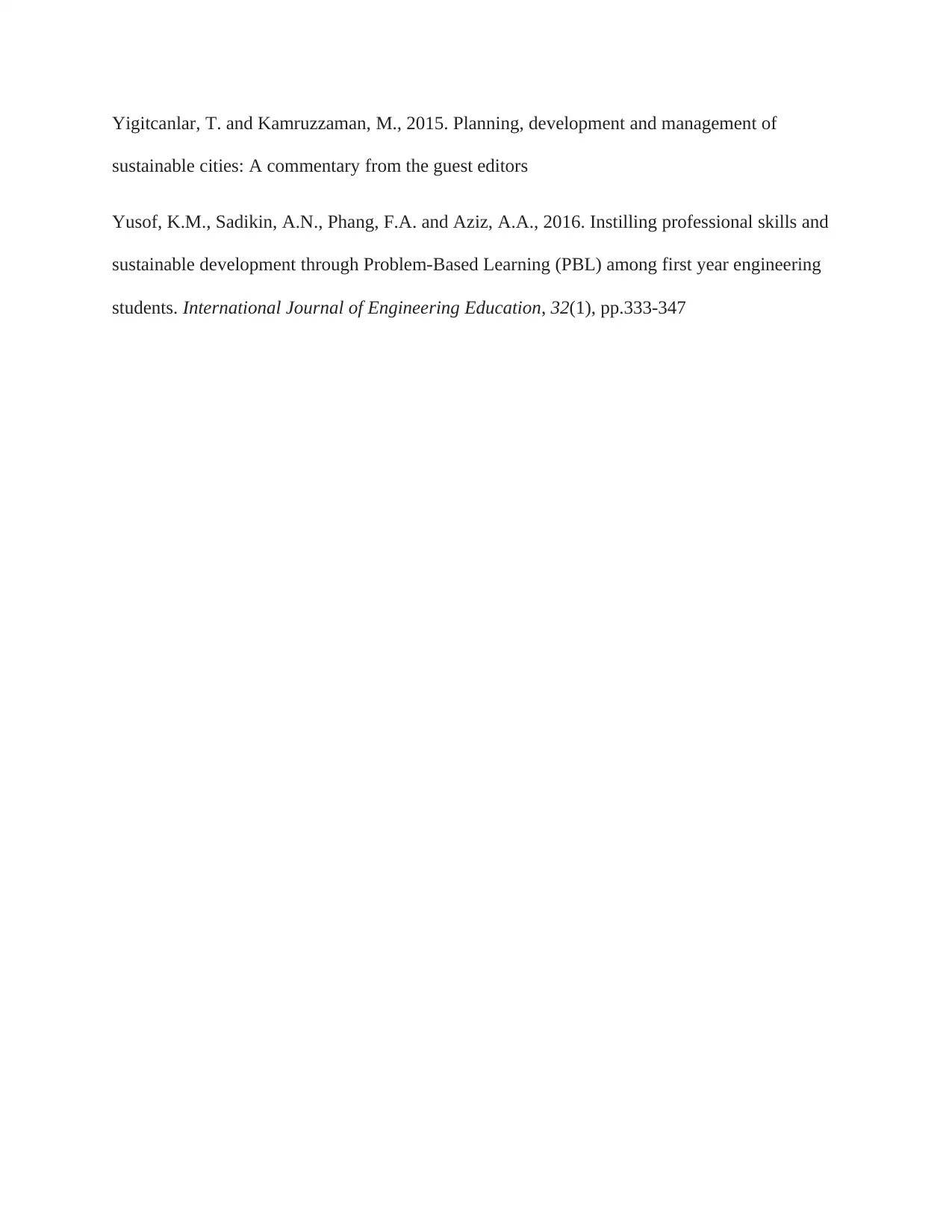
Yigitcanlar, T. and Kamruzzaman, M., 2015. Planning, development and management of
sustainable cities: A commentary from the guest editors
Yusof, K.M., Sadikin, A.N., Phang, F.A. and Aziz, A.A., 2016. Instilling professional skills and
sustainable development through Problem-Based Learning (PBL) among first year engineering
students. International Journal of Engineering Education, 32(1), pp.333-347
sustainable cities: A commentary from the guest editors
Yusof, K.M., Sadikin, A.N., Phang, F.A. and Aziz, A.A., 2016. Instilling professional skills and
sustainable development through Problem-Based Learning (PBL) among first year engineering
students. International Journal of Engineering Education, 32(1), pp.333-347
1 out of 10
Related Documents
Your All-in-One AI-Powered Toolkit for Academic Success.
+13062052269
info@desklib.com
Available 24*7 on WhatsApp / Email
![[object Object]](/_next/static/media/star-bottom.7253800d.svg)
Unlock your academic potential
Copyright © 2020–2025 A2Z Services. All Rights Reserved. Developed and managed by ZUCOL.





